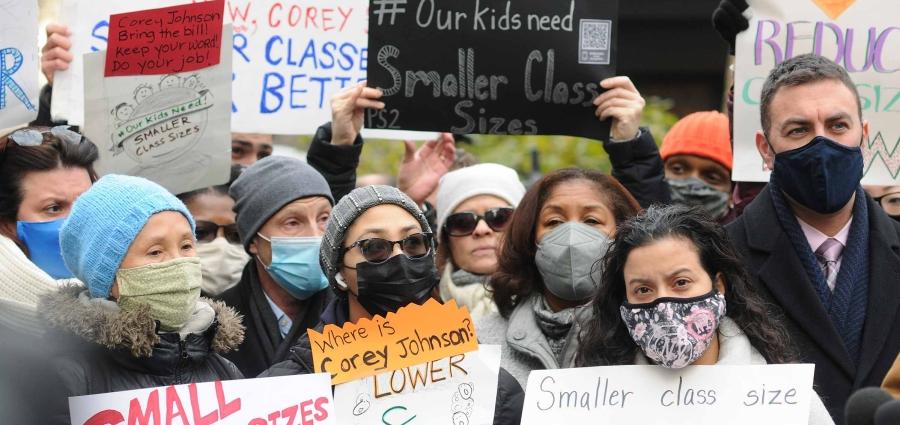Landmark law to lower city class sizes

Educators and parents voiced their support for smaller class sizes during a UFT press conference on reduced class size near City Hall on Dec. 9, 2021.
UFT members thanked Gov. Kathy Hochul in person on Oct. 12 for signing landmark legislation that will lower class sizes in New York City by a third, closing a decades-long gap between the city and the rest of the state.
UFT President Michael Mulgrew introduced the governor, who stopped in at the union’s Delegate Assembly, as the “greatest friend to public education in terms of the governor’s office that we’ve ever had” for supporting the class-size bill, a record level of education funding and other pro-education initiatives.
“She did more for the children, for the teachers, for everyone who dedicates their lives to education. She did it in less than one year,” Mulgrew said.
Hochul thanked UFT members for their dedication while voicing concern about the teacher shortage. “Smaller class sizes — we got that done. But also, I need more teachers. Whatever that spark was that drew you to channel your passion into this profession, I need to get that spark everywhere,” she told delegates, who gave her a standing ovation when she finished her remarks.
Hochul signed the class-size legislation on Sept. 8 after spending the summer making sure all of its provisions could be successfully implemented. State lawmakers overwhelmingly passed the bill in June.
Mulgrew has called the law “a groundbreaking change for our school system” and credited UFT members, parents and advocates for “raising their voices and articulating the importance of smaller class size for our students.”
The legislation, which was spearheaded by state Sen. John Liu, the chair of the Senate Committee on New York City Education, will lower class sizes for all grades. Currently, 98% of the state’s school districts have lower class sizes than New York City, according to the state Education Department.
The governor and state lawmakers agreed that this initiative requires significant strategic planning, so the agreement to sign the bill directs that the current school year be a planning year. The changes will go into effect beginning in September 2023, with 20% of classes citywide in compliance with the new limits each year of the five-year phase-in period. By September 2028, all classes in all schools will comply with the law. Schools with higher poverty rates will have priority during the phase-in process.
The law requires that maximum class sizes be reduced from 25 to 20 for kindergarten; 32 to 20 for grades 1–3; 33 to 23 for grades 4–8; and 34 to 25 for high school. The maximum size for high school physical education courses and performing groups will be 40. Individual schools can exceed the caps for elective and specialty classes if the school receives a waiver or if UFT members approve it in an SBO vote. Placement of a second teacher in a classroom is permitted only as a temporary measure.
During the planning year, the city and the Department of Education, in collaboration with the UFT and the principals’ union, will develop and sign off on a class-size reduction plan. It will detail how schools will achieve the targets and include a waiver process for schools that claim it would be a hardship due to space, over-enrollment, license-shortage areas or other issues. The city must have a strategy to overcome hurdles for schools with exemptions.
Where a popular school or program is over-subscribed now, the law requires the city to come up with a plan to increase the number of seats to meet both the demand and the new class-size limits.
Jason Klein, a physics teacher at Medgar Evers College Preparatory School in Crown Heights, Brooklyn, said the legislation is an investment in students that “provides a long-lasting solution” to overcrowding in city public schools.
When classes routinely have more than 30 students, he said, the teacher has more-limited time to monitor them and see how they’re doing, especially those who might be struggling.
“When class sizes are smaller, students and teachers get to know each other better, and they can forge relationships,” he said. “I think students will be motivated to work harder if they feel like they’ve made a connection with their teacher, and that leads to better outcomes.”